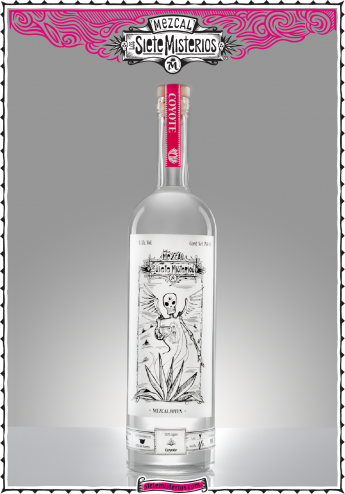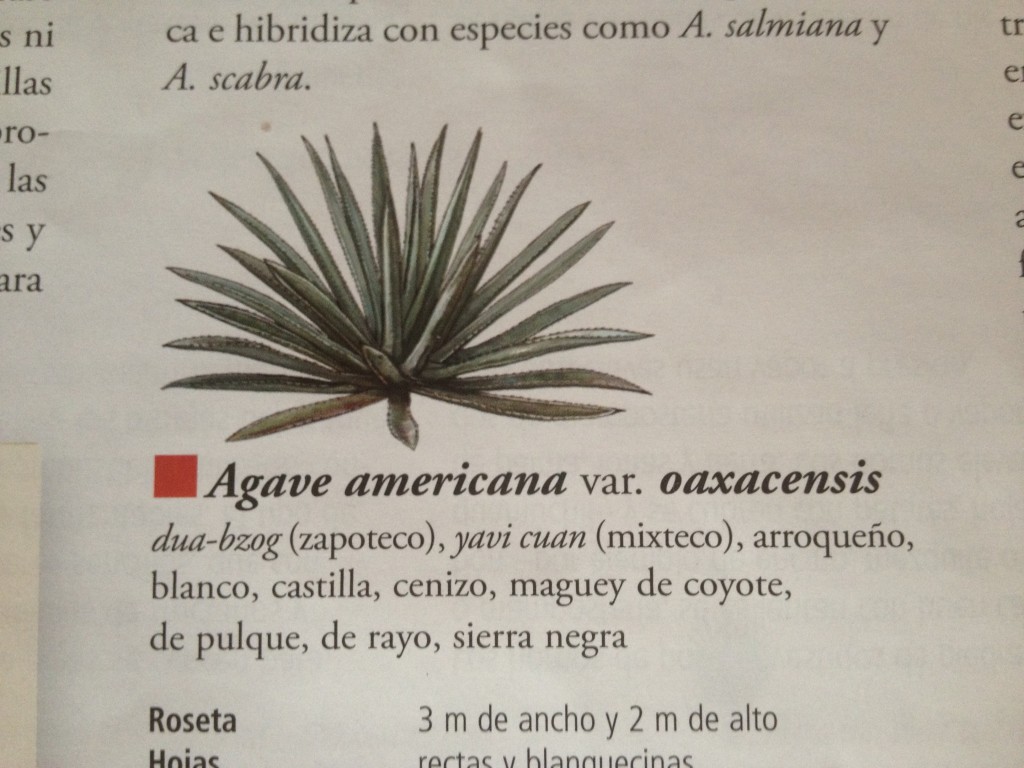So there I was, there I was, in the Congo. Oops, wrong story. There I was at the bar at Empellon in the West Village in NYC. Matt Resler, bartender extraordinaire, passionate agave expert, and all around good guy, was kindly pouring me what he believed to be was the release of a VERY SMALL BATCH production of Siete Misterios Mezcal. This brand is not yet available in the U.S., but is coming soon. Matt gets this stuff because, well, he is Matt. I wish I was Matt.
Why did Matt think this bottle of Siete Misterios was a very small batch? Because the bottle was hand numbered as bottle number 20 out of 21! Yes, bottle 20 of 21. Ahhh, I’m not sure what the definition would be of “small batch”, but I am guessing that this qualifies!
 This is not the actual bottle Matt had, but a shot from Siete’s website. At the bottom in the little square box, it says “Coyote”. The producer explained to Matt that this is the variety of agave. Interesting…..
This is not the actual bottle Matt had, but a shot from Siete’s website. At the bottom in the little square box, it says “Coyote”. The producer explained to Matt that this is the variety of agave. Interesting…..
Now we both found this to be very intriguing – something only another mezcal geek could really appreciate. Of course, neither of us had ever heard of an agave variety called “coyote”, and if you Google it, you will find nothing that suggests there is such a variety. But, with mezcal, you never know. As one academic told me, there are new species of Agave still being discovered and described from obscure canyons in Mexico. Not that they are really being “discovered”. It is simply becoming known that someone is making mezcal with a very regional, or micro-regional variety of agave. Discovered in an academic sense, yes. But perhaps the local people have been making mezcal with that agave for generations – in fact, probably so.
So back on the trail of Agave coyote, I see on the Misterios website that they say the agave species is “Agave Americana L.” But I know that agave species may have many varieties, sub-varieties, sub-species, etc. So I start digging.
Warning: Agave Nerds Only!
So if you are a regular reader of this blog, you know that I find this stuff to be very interesting (see my post “How Many Agave Varieties Can Be Used To Make Mezcal?”). Agave taxonomy here we come! Agave taxonomy is not the art of stuffing a dead agave and mounting it on you mantle, but rather it is the branch of science concerned with the botanical classification of all things agave.
You may ask, why is this important in the world of mezcal? For example, with tequila, it is really not an issue since all tequila is made from the blue agave. But mezcals are made from more than 30 varieties of agave, and each species, variety, sub-variety, or sub-species imparts a different flavor and character to the mezcal. Just as the variety of grape is important to wine, the variety of the agave is important to mezcal.
So let’s get back to Agave Americana L. and coyote. To gain a bit of academic insight, I contacted Wendy Hodgson, Research Botanist at the Curator of the Herbarium in Phoenix. She explained “Agave” is the genus, and “Americana” is what is called the specific epithet, and combined Agave Americana L. is the species. The “L.” is a nod to the author of the species name Carl Linnaeus (who, by the way, published his book categorizing many plants in 1753). There are somewhere north of 200 species of agave, and many of these have varieties, sub-varieties, and sub-species. While I cannot find anything online about agave coyote, after a bit of research, I believe it to be a sub-species, or sub-variety of the Agave Americana var. oaxacensis. So let’s get this straight: Agave is the genus, Agave Americana is the species, Agave Americana var. oaxacensis is the variety, and I THINK coyote is the sub-variety.

So here is why I think it is a sub-variety, and this is the only reference to it that I can find. Mezcal Arte Tradicional is a magazine published in Mexico and they did a special edition dedicated to mezcal.
Included with the magazine, there is a map with details on a number of important agave species which are used in mezcal production. In this picture, Agave Americana is the species and the variety (“var.”) is oaxacensis. Then beneath the headline variety, they name the sub-varieties, or subspecies – it is unclear to me whether these are subspecies or sub-varieties but I will find out. But clearly you see that one sub-variety is maguey de coyote – you have been discovered! Coyote, may you catch the Road Runner my friend!
You may also notice that arroqueno is a sub-variety, and you may have seen a number of mezcals made from this agave, including a recent release by Del Maguey. And I also happen to have a bottle of Mezcalero Release #4 that is blended with sierra negra agave. So it seems that Agave Americana var. oaxacensis and its sub-varieties are fairly represented in the mezcal world and that many fine mezcals have been made from this variety.
Are you beginning to get it? Or perhaps you already do. One of the amazing, special, intriguing, and fun things about mezcal is the discovery process. The agave matters. The terroir matters. The production process matters. And there are nuances in every step of the chain that can alter the character of the mezcal in oh so wonderful ways.
For this map, they reference a number of sources for their information including Agaves of Continental North America, by Howard Gentry, 1982. You can buy this book on Amazon for $55 (ouch), and I have purchased it while writing this blog post. So while I do not have it yet, it may fill in a gap or correct something I have said here.
So now we know: Siete Misterios Coyote is the real deal. But why such a small release? I have asked the Siete guys on their website, and they have not yet responded. Come on guys – this is important stuff! Perhaps not as important as Lindsey Lohan’s latest driving mishap, but important nevertheless.
And also, if it is not available in the U.S., why am I even bothering to write about it? Well, first, which I have not even mentioned, because it was really good. But more importantly, the process of figuring out what “coyote” agave might be, led me to a deeper understanding of agave varieties that can be used to produce mezcal. On the surface this appears to be a post about an obscure release from a non-U.S. brand, but to the Agave Nerd Herd (memberships still available), this is fun, interesting, and enlightening.
Finally, let’s get back to the taste of Siete Misterios Coyote. I thought it was sublime. It had the smooth, subtle fruity sweetness of a tobala, with just a hint of vanilla on the palette. I have no idea if we we will ever see it in the U.S., but it might be worth a trip to Oaxaca to find one!
As always, I hope you enjoyed this post, and until next time, drink mezcal!


Coyote is just Americ. Oax. there are no sub-species its mezcaliero slang for the name of the plant. Not a different variety. Those names on the map are different local names (the first in zapotec, the next in mixtec, the rest more modern) for the same plant. It is rare and only grows wild and it takes up to 30 years for each plant to mature. So they can not make a lot. It was originally a variety that the mezcalieros made just for themselves, since it’s so rare and you can’t cultivate it. Most batches will be well under 200L. It became popular in the past decade as people try to “scotch up” the mezcal market because it is so rare and good. Basically, it cost me 300 pesos/l from the maker, as opposed to 120/l for the (wild-sourced) espadin (puntas from the espadin, which is 72% instead of 55% is 150 pesos/l).
tl:dr: Coyote is a local slang name for the Agave Americ. Oax. It is not an unknown variety of that same plant. It is that plant.
Thanks for your comments. I am not sure if you noted the date of this post, but it is pretty much from another lifetime! I have learned a lot since then. And what I have learned disagrees with your conclusions, no offense. I know Agave americana var. oaxacensis to have 4 sub-varietals: arroqueno, sierra nevada, blanco and coyote. This is not just my conclusion as I know others with far greater knowledge than me on agave taxonomy who agree with this. If you have different information, please let me know. You can now find several coyotes in the US, including from Siete Misterios and El Jolgorio.
Re: sub-varietals or different regional names of A. Americana var. oaxacensis? I was just in Oaxaca a few weeks ago and can’t quite remember who I was talking to, but I think it was Graciela at Real Minero, when I specifically asked and was told that Sierra Negra and Arroqueño are both A. Amer. var. oax., same species, same varietal, not sub-varietals, just different names for the same plant, similar to what Owen was saying. Is there any kind of scientific proof that they are sub-varietals and not the same varietal? Do we need to test clippings side by side to prove it one way or the other? I want answers!
I hear you brother! I have never heard that Sierra Negra and Arroqueno are one in the same (agree with how you have otherwise classified them). Graciela knows her stuff, so I would defer to her if she said it. In the old book and new one (about to drop!), I have them as separate sub-varietals. If you learn more, I would love to know!
I was speaking to Jesus Ortega who runs archivomaguey in Oaxaca last week about tobala and papalomet. While I can’t really relay too much info, I got the impression that tobala has a lot of variation in shape/size/color and that they are a category that could benefit from further distinction (we had a tobala that was a 50:50 blend of 2 differnet tobalas from similar region. I couldn’t give detail past that without drawing how the spines are large and curved on one with fatter leaves and slimmer and smaller spines on the second as drawn for me during discussion). I also got the strong sense that even if related the papalomet come from the mixtec region and also differs enough that at least some do not consider it synonymos with tobala. And from my tasting of various papalomet I’d have to say I tend to think they likey differ as well as they are slightly less sweet and have more vegetal flavors (in the small sampling I’ve been able to have). Archivo has a ticunchui that is absolutely amazing if you can get your hands on some. He only had like 30L total of this so there is not much, but if you’re in town and he has some you MUST try it. Perhaps my all time favorite as of now (I love them all, who am I kidding). Great site, BTW.
Thanks for writing. I always view tobala as distinct from papalome, which I also view as equivalent to papalote and cupreata. But these subtle differences and debates are what make mezcal unique, fun, and super cool! Tobalas are small compared to the other 3, which I think are synonymous. But who knows for sure! Sounds like you picked up some great info! And I have no idea what a ticunchui is??? Can you tell me more?
Sent you a photo of one on instagram. All I really know is they are tiny looking and the one I had I believe was also mixtec reguion and a ceremonial distillation. You should def chat with Jesus at Archivo whenever you get back to Oaxaca as he is very knowledgeable on mixtec specific (and general) mezcal. I loved my tastings at In Situ and Mezcaloteca, but to me Jesus seems the most passionate and fun to talk mezcal with. Just an opinion again, all mezcal and most the mezcalerias we went to were great. I didn’t really try and talk to him in English, but I assume your Spanish is decent if you’re this deep into mezcal. 🙂
Also, what brought me to write in the first place: Couldn’t agree more with how great this bottle is. We bought 2 when we were in town! 😀
While in Oaxaca in February, I visited the distillery for Don Agave where I bought a bottle of Mezcal Joven de Coyote, only 215 bottles made. The tour began with an introduction of the six types of agave they use for their mezcals, one of them being the coyote variety (somewhere I have a picture of them). You might continue your research by calling them at 951-111-1350, asking for Matha Caronell or writing to donagave_mezcal@hotmail.com
Jorge Balderas is the magician that makes their wonderful product.
I still haven’t broken into my bottle (showing great restraint) waiting for that special moment.
Thanks for reading and the tip. I bought a bottle of Coyote while in Sola de Vega recently. It is really fantastic. There is still no coyote available in the US but I am sure one will arrive soon! I am going to call Don Agave and check them out!
Nice post! I was just at Don Agave 1 day ago and tasted a lot of Mezcal, and purchased a few bottles. I observed the distilling process and saw their distillery. Very cool and very rustic. One of the bottles I have purchased is from their premium line, which includes Coyote. I have been bothered by one aspect of the Coyote mezcal. More than once I was told that it was a relative of Peyote, and is rumored to cause hallucinogenic effects. Mezcal in general doesn’t cause hallucinations, which I think is also a general rumor… but this particular one supposedly does. I’ve yet to drink enough of it to make an assessment. My bottle isn’t even opened yet! Have you come across anything about the relation between the Coyote Agave and the Peyote Cactus? Thanks!
I am not a botanist but I am 100% confident that Agave coyote and Peyote cactus have nothing in common (other than they rhyme!). Coyote is a varietal of Agave americana var. oaxacensis, which also includes arroqueno. I have had several coyote mezcals and they are definitely in the same taste profile as arroquenos, of which I have had many. No hallucinations – only a great buzz!
So agave is agave and cactus is cactus and they are biologically different and distinct. So whoever told you they are related was either trying to sell you more mezcal, trying to keep alive some unnecessary myth about mezcal, or just plain dumb.
If you are super curious, go to Wikipedia and lookup Agave, Cactus, and Peyote Cactus. On the right hand side they have all the scientific classifications of each. You will see that about all agave and cactus have in common is that they are both in the plant kingdom.
At any rate, thanks for reading and I hope you enjoy that coyote – the cannot be found in the U.S.
Sorry about a reply nine years later, but I’ve got a story I think you’d appreciate. I was cycling from Texas to South America in February 2014 (around when these comments were posted) and came across one of the owners of Don Agave, mentioned above. We started hanging out and he asked me if I wanted to visit the parador. He said I could have as much mezcal I wanted if I acted like a tourist and hyped up the place to American visitors, trying to upsell to the more expensive types of mezcal.
One of these selling points is to wink-and-nod that the coyote variety could possibly be hallucinogenic which is why it commands the hefty price tag. I probably went through half a bottle of that stuff a day for a solid week, but earned every penny!
While browsing Mezcals available from the US I found another mention of coyote in the Mezcal Vago Olla De Barro Coyote mixto (there is a mouthful.) As suggested, it is not a pure expression- the write up states that it is a mixture of ” various amounts of Espadin, Mexicano, Coyote, Arroqueño and Sierra Negra” and that the bottles will be labelled as to their contents.
I had never looked at or for Coyote prior to reading your blog and I have to say that I really appreciate the time you spend writing informative for my consumption.
I cannot believe the selection (and price) you pay south of the boarder (Canadian boarder.) I will refrain from ranting here (for now), but I see a trip to the Montana boarder in my near future… Suffice to say that right now I have bottles of Sombra and few other varieties (do zygnum and Scorpion count?) due to prices and availability. I refuse to pay twice the going rate for a bottle simply due to being geographically disadvantaged and living in a liquor dictatorship where the government holds a monopoly. (Right, I promised not to rant…)
Anyhow, thanks again for the posts and the links of various online mezcal Mecca’s for me to check out.
I was unaware of the brutal pricing you face in Canada. Sorry to hear that. Sounds like you love mezcal, and rightfully so! I don’t think you are going to find much mezcal in Montana though. Perhaps you know someone there and could send them a big online shipment and you can go pick it up? Even living in NYC, I buy most of my mezcal online because that’s where I find the best selection as well.
As for Agave Coyote, I bought one in Oaxaca a few months ago and it is divine. Very arroqueno-like. I still don’t know of a pure Coyote available in the U.S., but the Vago ensemble you mention is great. Thanks for reading and keep on drinking mezcal!
Siete Misterios gets their mezcal from the Sola de Vega region. It’s all “Olla de Barro”. The interesting thing is when you ask the mezcaleros from Sola to point out an Agave Arroqueño and an Agave Coyote, they are completely different and don’t appear to be of the same variety at all. Arroqueños are huge and have a much broader leaf. It would be nice to get to the bottom of this!
VERY interesting! Thanks for that. I have been working on a piece for a long time about the varieties of agave used to make mezcal. I put one up last year, but I have learned a lot since so that post has some incorrect or incomplete info. This helps. I will take all you’ve got on varietals!
Cool! I’ll let you as I check into it myself. I just double checked my notes and photos and realized that though the arroqueño is much larger, it is the coyote with the much broader leaf. I’ll link you to a blog post with photos that I’m working on as soon as I finish!
I agree with you. Both Arroqueno and Coyote are from the species Agave americana L. (var oaxacensis). They are separate sub-varieties, and you are confirming that fact by pointing out that they simply do not look the same. I have also seen mezcals made with at least one other sub-variety of this species, sierra negra, which is blended into Mezcalero Release #4. Finally, you mention Siete Misterios. Not that we need further evidence, but actually have bottles of Arroqueno and Coyote, so clearly they are distinct agave! Thanks again for the input!
a thorough and entertaining treatise to be sure! …great writing and I think I’ll pour myself a Ilegal Anejo gifted to me by some dude I know….
Glad you enjoyed it! Keep on reading’ and keep on drinkin’!
love this post! wait until you check out the most recent bottle I have received…cowhide/clay/7 years underground, Papalometl!
haven’t opened the bottle yet, figured it’s been waiting since “6/98” (yes, that is handwritten on the bottle) to be opened, then I can perhaps wait until a certain mezcal aficionado/blogger stops in for a dram. until then, Sir!
As you know Agave potatorum is the species for papalometl and tobala. I BELIEVE, but am not certain, that tobala is a subspecies or subvariety of potatorum (as opposed to just a synonym for potatorum). But I believe that tobala and papalometl are synonyms. Tobala is the zapoteco word and papalometl is the nahuatal word. It is certainly possible that they are both just native words for potatorum, and not subvarieties. Do you know? At any rate, my pursuit of agave taxonomy continues and I will get to the facts.
As for your bottle, I am not sure where cowhide fits in, so I need some help with that one! But for everything else, it sounds too good to be true. Am I being Punked?! I will let you know when I am stopping in Empellon for sure. How do you get these bottles? I said it once, and I will say it again: I wish I was Matt.
What a fantastic lesson on mezcal!! So interesting and so easy to read and understand!! As I was reading it my mouth was watering thinking of the Siete Misterios at Empellon with Matt Resler and the numbered bottles!! By your description I can imagine how tasteful it is and the pleasant burning sensation that gives a good mezcal to one’s palate. Well, how about some Ilegal for now?!!
It Ilegal is your fall back plan, you are in great shape! Thanks for reading!